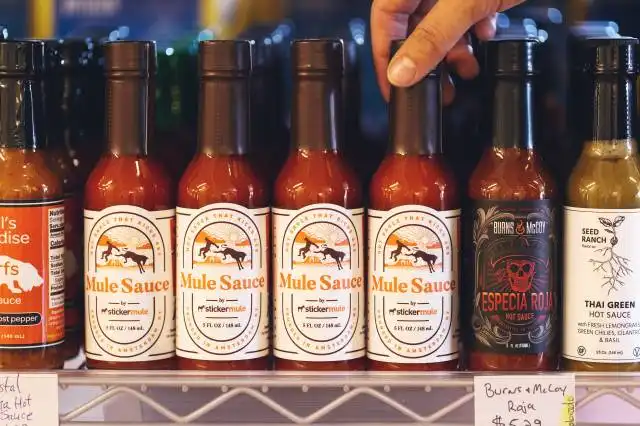Start a Bread Bakery
Kneading Your Way to Success: The Rise of Bread Bakery Business
| Updated


BREAD BAKERY
There's nothing like the aroma of freshly baked bread wafting along your morning route to kick-start a day. Lacing your entrepreneurial journey with a Bread Bakery business could be your yeast to success! At its core, a Bread Bakery involves crafting, baking, and selling a variety of breads – from the classic sourdough to unique flavor-infused loaves. As a new entrepreneur, knead your creativity into the dough of opportunity and your business could rise to great heights!
Jump to Business Plan
RELATED BUSINESS IDEAS
Browse ALL Food & Beverage Entrepreneurship Business Ideas
Discover Your Perfect Domain
Unlock the door to your online success with our hand-picked selection of premium domain names. Whether you're starting a new venture or rebranding an existing one, the right domain can set the tone for your digital presence. Browse through our curated list, each with its unique potential to enhance your brand's visibility and credibility.
BREAD BAKERY MINI BUSINESS PLAN
This a quick reality check to help you identify the strengths and weaknesses of your business concept before you dive in.
Expected Percent Margin:
- Gross Margin: 70-75%
- Net Profit Margin: 8-12%
Earnings Expectations:
- Daily Earnings: $150 - $400
- Weekly Earnings: $1,050 - $2,800
- Monthly Earnings: $4,500 - $12,000
- Annual Earnings: $54,000 - $144,000
Actions to Hit Those Numbers:
Cost of Bread Production:
- Initial Investment: Around $10,000 depending on the bakery's scale and variety.
- Quality Ingredients: Sourcing high-quality, and possibly organic, flours, yeasts, and salts.
Marketing and Customer Acquisition:
- Social Media: Use food photos via platforms popular with your target market.
- Sampling: Workshops, free samples, and local fairs generate word-of-mouth publicity.
Sales and Customer Experience:
- Staffing: Employ at least 2-3 trained bakers and 1-2 salespersons.
- Product Line: Offer a range of bread types - classic, wholegrain, gluten-free, etc.
Cost Control:
- Rent: Rent ideally should not exceed 10% of expected monthly sales.
- Utilities and Maintenance: Plan for $400-$700 per month.
Business Operations:
- Open Hours: 6-7 days a week, more hours on weekends and holidays.
- Transaction Volume: Aim for selling 50-100 loaves and other products daily, with an average price of $3-$7.
Please note these are rough estimates and can significantly vary based on your specific situation. It's always recommended to talk with an experienced financial advisor or baker in your specific locality.
NOT WHAT YOU HAD IN MIND? Here are more ideas



Browse ALL Food & Beverage Entrepreneurship Business Ideas
Grab Your Business Website Name
Before you get caught up in the whirlwind of setting up your business, invest in a domain name. It's a small but significant step that lays the foundation for your brand and makes it easier for customers to find and trust you. Just like you wouldn't build a house without securing the land first, don't build a business without securing your domain name.
"Why? Can't that wait?" Here's why it shouldn't
Step 1: Determine if Starting a Bread Bakery is Right for You
Breakdown of Startup Expenses
Before starting a bread bakery, it is important to understand the startup costs associated with the business. This includes the cost of the equipment, such as ovens, mixers, and other baking tools, as well as the cost of ingredients, such as flour, sugar, and yeast. Additionally, there may be costs associated with renting a commercial kitchen space, obtaining the necessary permits and licenses, and hiring staff. It is important to understand the full cost of starting a bread bakery before taking the plunge.
Breakdown of Ongoing Expenses
Once the bread bakery is up and running, there are ongoing costs associated with the business. This includes the cost of ingredients, such as flour, sugar, and yeast, as well as the cost of packaging materials, such as bags and boxes. Additionally, there may be costs associated with marketing and advertising, as well as the cost of staff wages. It is important to understand the full cost of running a bread bakery before taking the plunge.
Examples of Ways to Make Money
There are many ways to make money with a bread bakery. The most obvious way is to sell the bread directly to customers. This can be done through a retail storefront, online store, or through a delivery service. Additionally, bread can be sold to restaurants, cafes, and other food service establishments. Finally, bread can be sold at farmers markets or other local events. It is important to understand the different ways to make money with a bread bakery before taking the plunge.
Step 2: Name the Business
Brainstorm ideas When coming up with a name for the business, it is important to brainstorm a variety of ideas. Consider what the business will specialize in, the location, and any other factors that could be used to create a unique and memorable name. It is also important to ensure the name is easy to pronounce and spell.
Research the name Once a few ideas have been generated, research the name to ensure it is not already in use. This can be done by searching online, checking with the local chamber of commerce, and registering the name with the state.
Consider the logo When selecting a name, it is important to consider how the logo will look. The logo should be simple, memorable, and easy to recognize. It should also be easy to reproduce in a variety of formats.
Choose a domain name Once the business name has been selected, it is important to choose a domain name. This will be used for the website and email address. It should be easy to remember and should match the business name as closely as possible.
Register the business name Once the business name has been chosen, it is important to register it with the state. This will ensure that the name is legally protected and that the business is in compliance with all local laws.
Step 3: Develop a Business Plan
Introduction: A business plan is an essential document for any business, regardless of size. It outlines the goals and objectives of the business, as well as the strategies and tactics that will be used to achieve them. The plan should also include financial projections, a marketing plan, and a description of the business’s competitive advantage.
Executive Summary: The executive summary is the first section of the business plan and should provide an overview of the business and its goals. It should include a brief description of the business, its products and services, the target market, and the competitive advantage.
Market Analysis: The market analysis should include an overview of the industry, an analysis of the target market, and an assessment of the competitive landscape. It should also include an analysis of the market’s growth potential and an estimate of the business’s potential market share.
Financial Plan: The financial plan should include a detailed breakdown of the startup costs, ongoing expenses, and projected revenues. It should also include an analysis of the business’s cash flow and a break-even analysis.
Marketing Plan: The marketing plan should include a description of the business’s target market, the strategies and tactics that will be used to reach them, and a timeline for implementation. It should also include an analysis of the competitors and an assessment of the business’s competitive advantage.
Management Plan: The management plan should include a description of the business’s organizational structure, the roles and responsibilities of each position, and a description of the skills and experience of the key personnel. It should also include a description of the business’s policies and procedures.
Conclusion: The conclusion should provide a summary of the key points of the business plan and a description of the next steps. It should also include a timeline for implementation and a call to action.
Step 4: Obtain Financing
When it comes to financing a bread bakery, there are a variety of options available. These include traditional loans from banks, small business loans from the Small Business Administration, and private investors. Additionally, crowdfunding platforms such as Kickstarter and GoFundMe can be used to raise money for the business. It is important to research all of these options to determine which one is best for your business.
Applying for Financing
Once you have determined which financing option is best for you, it is time to begin the application process. This process can be time-consuming and require a lot of paperwork, so it is important to be prepared. You will need to provide financial statements, a business plan, and other documents to support your application. Additionally, you will need to provide information about your business, such as the type of bread you will be selling, the size of your bakery, and the estimated cost of startup.
Tips for Securing Financing
When applying for financing, it is important to be organized and prepared. Make sure that all of your documents are in order and that you are able to answer any questions the lender may have. Additionally, it is important to have a clear plan for how you will use the money and how you will repay the loan. Finally, it is important to be realistic about the amount of money you need and to be prepared to negotiate with the lender.
Step 5: Secure a Location
Introduction When it comes to starting a bread bakery, one of the most important steps is finding the right location. It is important to take the time to find a location that is suitable for a bakery, as it can make or break the success of the business.
Consider the Foot Traffic When looking for a location, it is important to consider the foot traffic in the area. A bakery needs to be in an area that has a lot of people passing by, as this will help to drive sales. It is also important to consider the competition in the area, as there may be other bakeries that are already established.
Look for a Space with the Right Amenities The space should also have the right amenities to accommodate a bakery. This includes things like a kitchen, storage space, and a seating area. It is also important to consider the size of the space, as it should be large enough to accommodate the equipment and supplies needed for a bakery.
Consider the Cost When looking for a location, it is important to consider the cost. Depending on the area, the cost of rent can vary significantly. It is important to find a location that is within the budget of the business.
Negotiate the Lease Once a location has been found, it is important to negotiate the lease. This includes things like the length of the lease, the cost of rent, and any other terms that are included in the lease. It is important to make sure that the lease is fair and that all terms are agreed upon before signing.
Conclusion Finding the right location for a bread bakery is an important step in the process. It is important to take the time to find a location that is suitable for a bakery, as it can make or break the success of the business. Consider the foot traffic, look for a space with the right amenities, consider the cost, and negotiate the lease. With the right location, a bakery can be successful.
Step 6: Obtain Necessary Licenses and Permits
Before opening the bakery, it is important to obtain the necessary licenses and permits. Depending on the location of the bakery, the types of licenses and permits needed may vary. Generally, a bakery will need a business license, food service license, and a health permit. It is important to research the specific licenses and permits required in the area where the bakery will be located.
Business License
A business license is required to legally operate a business. This license is typically obtained from the local government. The application process for a business license can vary depending on the location and type of business. For a bakery, the application process may include filling out an application, providing proof of business insurance, and paying a fee.
Food Service License
A food service license is required to legally serve food to the public. This license is typically obtained from the local health department. The application process for a food service license may include filling out an application, providing proof of food safety training, and paying a fee.
Health Permit
A health permit is required to ensure the safety of the food served at the bakery. This permit is typically obtained from the local health department. The application process for a health permit may include filling out an application, providing proof of food safety training, and paying a fee.
Other Licenses and Permits
In addition to the business license, food service license, and health permit, there may be other licenses and permits required to operate a bakery. For example, a bakery may need a liquor license if it serves alcohol. It is important to research the specific licenses and permits required in the area where the bakery will be located.
Step 7: Purchase Equipment
When starting a bread bakery, it is important to purchase the right equipment to ensure that the bakery runs smoothly and efficiently. Essential equipment includes ovens, mixers, proofers, and dividers. Ovens are needed to bake the bread and come in a variety of sizes and types. Mixers are used to mix the dough and come in both planetary and spiral varieties. Proofers are used to proof the dough and come in both retarder-proofers and proof boxes. Lastly, dividers are used to divide the dough into the desired sizes.
Where to Purchase Equipment
When purchasing equipment, it is important to research different suppliers to find the best deals. Many suppliers offer new and used equipment, so it is important to compare prices and features. Additionally, some suppliers offer financing options, which can be helpful for those who are just starting out. It is also important to consider the quality of the equipment and the reputation of the supplier.
Cost of Equipment
The cost of equipment can vary greatly depending on the type and quality of the equipment. Ovens can range from a few hundred dollars to several thousand dollars, depending on the size and type. Mixers can range from a few hundred dollars to several thousand dollars, depending on the type and capacity. Proofers can range from a few hundred dollars to several thousand dollars, depending on the size and type. Lastly, dividers can range from a few hundred dollars to several thousand dollars, depending on the size and type.
Maintenance of Equipment
In addition to purchasing the equipment, it is important to consider the cost of maintenance. Ovens, mixers, proofers, and dividers all require regular maintenance to ensure that they are running properly. This includes cleaning, lubricating, and replacing parts as needed. It is important to research the maintenance requirements for each piece of equipment and factor that into the overall cost.
Step 8: Market the Business
Now that the business is up and running, it is time to start marketing. There are many ways to market a business, including traditional methods such as print advertising, radio and television advertising, and direct mail campaigns. Additionally, there are a variety of digital marketing strategies, such as search engine optimization (SEO), content marketing, and social media marketing.
Examples of Specific Marketing Strategies
When it comes to marketing a bread bakery, there are a few specific strategies that can be used. For example, offering discounts or coupons for customers who purchase multiple loaves of bread, or offering free samples of new products, can be effective ways to draw in new customers. Additionally, partnering with local restaurants and stores to provide them with fresh bread can be a great way to increase sales. Finally, creating a website and using social media to promote the business can be a great way to reach a wider audience.
Tips for Effective Marketing
When it comes to marketing a bread bakery, it is important to be creative and think outside the box. Utilizing local resources such as newspapers, radio stations, and community bulletin boards can be a great way to reach potential customers. Additionally, offering discounts and promotions can be a great way to draw in new customers. Finally, creating a website and using social media to promote the business can be a great way to reach a wider audience.
Step 9: Open the Business
- Start small and grow as you become more experienced. Opening a full-scale bakery right away can be overwhelming and expensive. Start with a small retail space or a booth at a local farmers market.
- Make sure you have the necessary licenses and permits. Depending on the area, you may need a business license, health permit, and food handler’s license. Contact your local government to determine what you need.
- Develop a marketing plan. You will need to create a strategy for getting the word out about your bakery. This can include creating a website, advertising in local publications, and attending events.
- Hire employees. If you plan to open a full-scale bakery, you will need to hire employees to help with the baking and customer service. Make sure to thoroughly vet any potential employees and create a comprehensive employee handbook.
- Purchase the necessary equipment. You will need to buy ovens, mixers, and other baking equipment. You may also need to buy furniture and decorations for the retail space.
- Create a menu. You will need to decide what types of breads, pastries, and other items you will offer. Make sure to create a menu that appeals to a wide range of customers.
- Have a grand opening. Once you are ready to open, plan a grand opening event. Invite the local media and create promotional materials to spread the word.
- Monitor your finances. Make sure to keep track of your expenses and profits. This will help you determine if the business is successful and if you need to make any changes.
EXPLORE MORE CATEGORIES
Browse ALL Business Idea Categories
TAKE THE NEXT STEPS










